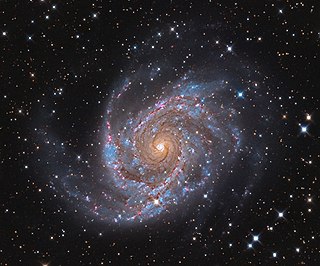
NGC 2997 is a face-on unbarred spiral galaxy about 40 million light-years away in the faint southern constellation of Antlia. It was discovered March 4, 1793 by German-born astronomer William Herschel. J. L. E. Dreyer described it as, "a remarkable object, very faint, very large, very gradually then very suddenly bright middle and 4 arcsec nucleus. This is the brightest galaxy of the NGC 2997 group of galaxies, and was featured on the cover of the first edition of Galactic Dynamics by James Binney and Scott Tremaine.

The NGC 2841 group is a group of galaxies about 19.6 million light-years away from Earth. It includes the loose triplet NGC 2541, NGC 2500, and NGC 2552. NGC 2841 is the fourth-brightest galaxy in Ursa Major with an apparent magnitude of 9.2. It is 20' southeast of 3 Lyncis and just below the halfway point of an imaginary line between Theta and 15 Ursae Majoris.
The Canes II Group or Canes Venatici II Group is a group of galaxies about 26.1 million light-years away from Earth. The group resides in the Local Supercluster. The largest galaxy within the cluster is M106, which is a barred spiral galaxy.
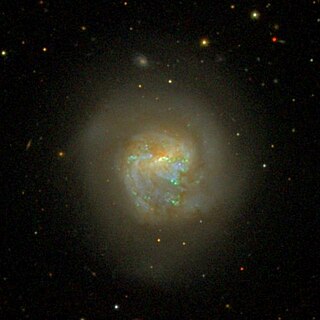
NGC 5713 is a peculiar, asymmetric galaxy in the constellation Virgo. Although classified as a spiral galaxy by most galaxy catalogs, NGC 5713 is very different from most normal spiral galaxies. While most spiral galaxies either have either two well-defined spiral arms or a filamentary spiral-like structure, this spiral galaxy has only one visible spiral arm in its disk. This makes it a galaxy of the Magellanic type. Gravitational interactions with the nearby spiral galaxy NGC 5719 may be responsible for producing the disturbed, asymmetric structure including the single spiral arm.
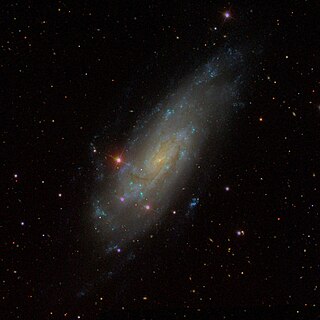
NGC 4559 is an intermediate spiral galaxy with a weak inner ring structure in the constellation Coma Berenices. Distance estimates for NGC 4559 range from about 28 million light-years to 31 million light-years, averaging about 29 million light-years.
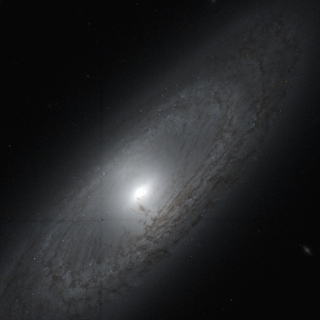
NGC 4448 is a barred spiral galaxy with a prominent inner ring structure in the constellation Coma Berenices.

NGC 5705 is a spiral galaxy in the constellation Virgo. NGC 5705 is part of a small group of spiral galaxies that also includes NGC 5691, NGC 5713, and NGC 5719. It is a member of the NGC 5746 Group of galaxies, itself one of the Virgo III Groups strung out to the east of the Virgo Supercluster of galaxies.
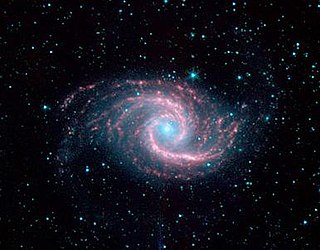
The Dorado Group is a loose concentration of galaxies containing both spirals and ellipticals. It is generally considered a 'galaxy group' but may approach the size of a 'galaxy cluster'. It lies primarily in the southern constellation Dorado and is one of the richest galaxy groups of the Southern Hemisphere. Gérard de Vaucouleurs was the first to identify it in 1975 as a large complex nebulae II in the Dorado region, designating it as G16.

NGC 4206 is a spiral galaxy located about 70 million light-years away from Earth in the constellation of Virgo. The galaxy is visible with most moderate amateur telescopes at 13th magnitude. It was discovered by British astronomer William Herschel on 17 April 1784 and is a member of the Virgo Cluster.
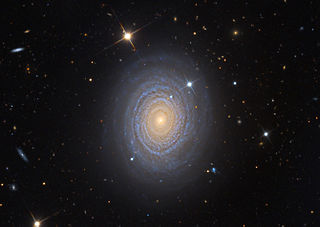
NGC 488 is a face-on spiral galaxy in the constellation Pisces. It is at a distance of about 90 million light-years away from Earth. Its diameter is estimated to be 52,6 Kpc. The galaxy has a large central bulge, and is considered a prototype galaxy with multiple spiral arms. Its arms are tightly wound. Star forming activity has been traced within the arms. The nucleus of NGC 488 has been found to be chemically decoupled, being twice as metal rich as the central bulge of the galaxy. NGC 488, with the exception of its smaller companions, that form NGC 488 group, is an isolated galaxy.

NGC 936 is a barred lenticular galaxy in the constellation Cetus. It is at a distance of about 60 million light-years away from Earth. Its nucleus and prominent bar have high surface brightness. Because of the shape of the prominent bar, the nucleus and the ring of stars at the end of the barrel, the galaxy has been compared with the shape of a TIE fighter, from the Star Wars universe, and thus NGC 936 has been named Darth Vader’s Galaxy or Darth Vader’s Starfighter. By measuring the radial velocity of the disc, Kormendy found in 1986 that the disc is stable, which is the reason why it is so smooth.

NGC 1964 is a barred spiral galaxy in the constellation Lepus. The galaxy lies 65 million light years away from Earth, which means, given its apparent dimensions, that NGC 1964 is approximately 100,000 light years across. At its center lies a supermassive black hole, with estimated mass 2.5 × 107M☉. The galaxy features two tightly wound inner spiral arms within a disk with high surface brightness and two outer, more open spiral arms that originate near the inner ring. The outer arms feature few small HII regions.

NGC 5861 is an intermediate spiral galaxy in constellation Libra. It is located at a distance of about 85 million light years from Earth, which, given its apparent dimensions, means that NGC 5861 is about 80,000 light years across.

NGC 4274 is a barred spiral galaxy located in the constellation Coma Berenices. It is located at a distance of circa 45 million light years from Earth, which, given its apparent dimensions, means that NGC 4274 is about 95,000 light years across. It was discovered by William Herschel in 1785.

NGC 3726 is a barred spiral galaxy located in the constellation Ursa Major. It is located at a distance of circa 45 million light years from Earth, which, given its apparent dimensions, means that NGC 3726 is about 85,000 light years across. It was discovered by William Herschel on February 5, 1788.
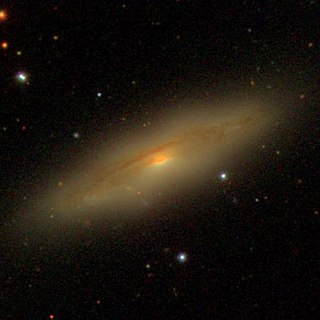
NGC 4586 is a spiral galaxy located about 50 million light-years away in the constellation Virgo. The galaxy was discovered by astronomer William Herschel on February 2, 1786. Although listed in the Virgo Cluster Catalog, NGC 4586 is considered to be a member of the Virgo II Groups which form a southern extension of the Virgo cluster. NGC 4586 is currently in the process of infalling into the Virgo Cluster and is predicted to enter the cluster in about 500 million years.
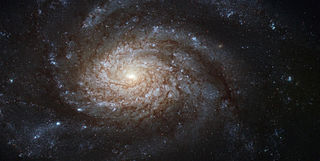
NGC 3810 is a spiral galaxy located in the constellation Leo. It is about 50 million light years from Earth, and estimated to be about 60,000 light years in diameter. William Herschel discovered it on 15 March 1784.
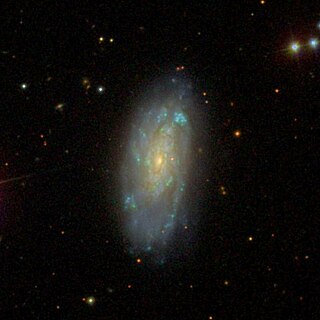
NGC 7448 is a spiral galaxy located in the constellation Pegasus. It is located at a distance of circa 80 million light years from Earth, which, given its apparent dimensions, means that NGC 7448 is about 60,000 light years across. It was discovered by William Herschel on October 16, 1784. It is included in the Atlas of Peculiar Galaxies in the category galaxies with detached segments.

NGC 779 is a spiral galaxy seen edge-on, located in the constellation Cetus. It is located at a distance of circa 60 million light years from Earth, which, given its apparent dimensions, means that NGC 779 is about 70,000 light years across. It was discovered by William Herschel on September 10, 1785.
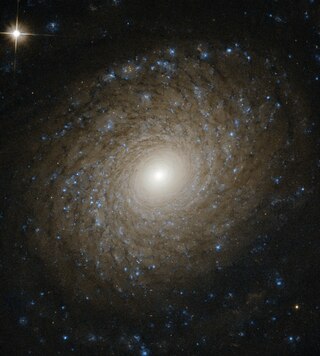
NGC 2985 is a spiral galaxy located in the constellation Ursa Major. It is located at a distance of circa 70 million light years from Earth, which, given its apparent dimensions, means that NGC 2985 is about 95,000 light years across. It was discovered by William Herschel on April 3, 1785.
G. De Vaucouleurs, 1975. Nearby Groups of Galaxies, ch. 5. the nearer groups within 10 megaparsecs. Published in "Galaxies and the Universe," ed. by A. Sandage, M. Sandage and J. Kristian.



















